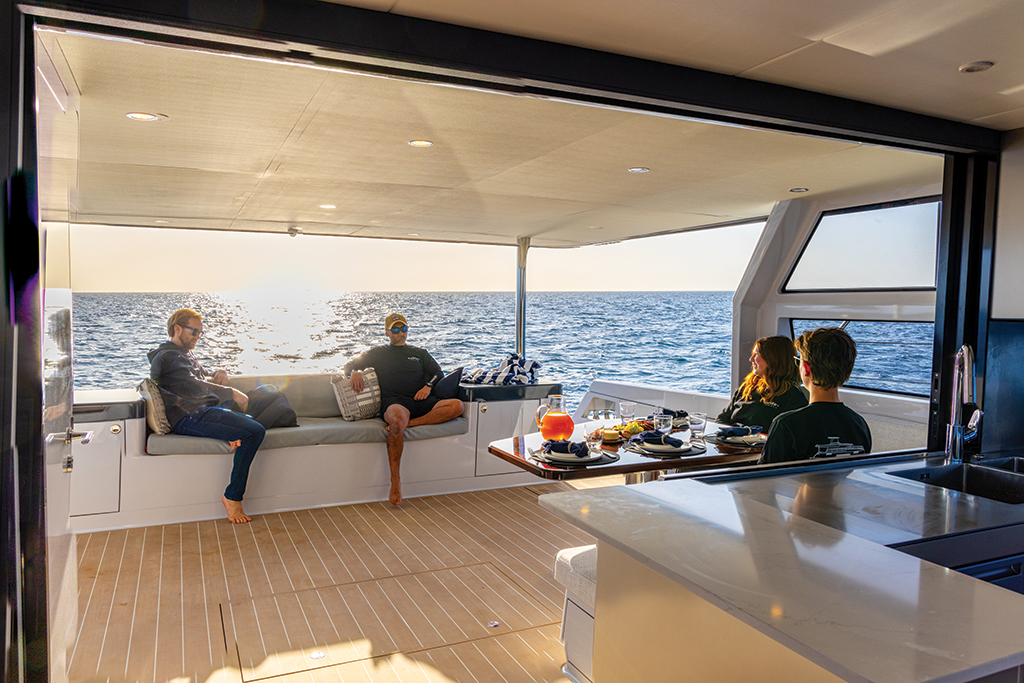
The DEMEY 60 can cover more than 2,200 nautical miles at 9 knots without refueling.
Sailors or couples looking to make the transition from a sailboat to a powerboat typically look at a trawler-style displacement boat, but a new catamaran from New Zealand gives them another option.
The DEMEY 60 from Nic de Mey Yachts is powered by twin 550-hp lightweight Cummins diesels and has an estimated range of 2,238 nautical miles at 9.3 knots. That breaks down to 9.77 gallons per hour and 1.06 gallons per nautical mile.
“That’s exactly what it’s targeted at with not only range but speed,” said Nic de Mey, founder of Nic de Mey Yachts in Mt. Maunganui, New Zealand, during a Teams call. “Particularly here in New Zealand, there are many boaters who want to go to Fiji but haven’t done it or they have to hire a crew and put a bunch of fuel bladders in the cockpit.”
Looking at some other numbers with the DEMEY 60, when speed picks up to 12.7 knots, the range is still an impressive 1,525 nautical miles with the boat burning 20.1 gph and 1.56 gpnm. Advance the throttles a little more to 18 knots and the range doesn’t drop much to 1,465 nautical miles as the boat consumes 28.27 gph and uses 1.6 gallons to cover a nautical mile. Pick up the speed to 22 knots and the range is 1,200 nautical miles, burning 43.59 gph and 1.98 gpnm. All figures are based on 90 percent fuel capacity. During the DEMEY 60’s delivery voyage from New Zealand to Sydney, Australia, the yacht covered the notoriously rough 1,200 nautical-mile passage in 3 days, 3 hours averaging 16 knots.

Unlike many new models with longer range, the DEMEY 60’s designer, Roger Hill, kept things basic. It’s a semi-displacement catamaran with straight-shaft inboards. The propellers are nestled in prop tunnels to improve efficiency. Because it’s a semi-displacement design, the boat doesn’t rely on hydrodynamic lift. As it increases speed, it does lift somewhat out of the water, but its long narrow sponsons are designed to slice through the water. Top speed with the Cummins 550s is 28 knots.
“There’s nothing special about the driveline whatsoever,” said de Mey. It’s really simple.” Veem bronze propellers are used because they are designed with plastic strips on the trailing edge to adjust the pitch. This is helpful if you are running the boat light or fully loaded.
“The boat was designed for 450-hp Cummins or Yanmars,” de Mey said. “I chose Cummins because it’s a good brand and they were the lightest engines I could find. The difference between the 450 and 550 here in New Zealand is negligible in weight and price so ordering the 550s was a no brainer.”

When designing the boat, semi displacement was preferred over a foiling catamaran. A foiler would run faster, but the ride could be compromised in rough water. “When could you actually run foiling speeds,” he asked. “You certainly aren’t going to do it with your wife, your kids and grandkids on board.”
Consumer Request
The DEMEY 60 was built for a Nic de Mey Yachts customer who is an ex-professional sailor who competed in the America’s Cup and other big events. He owns a Riviera yacht that’s built in Australia, but he wanted more range than that vessel can cover.
“He’s in Sydney and it’s quite a rough harbor,” de Mey explained. “There’s a cruising ground about (20 nautical miles) up the coast called Pittwater and it’s just a magical spot; he goes there quite a bit. He goes to Hamilton Island once a year and he wants to go to Fiji and the Great Barrier Reef.”
The owner uses the boat daily, either as a workspace in the marina or heading out on the water. He’s been to Brisbane, which is an 800 nautical mile return trip. With the torque of the inboard transmissions with a 1.962:1 gear ratio and twin Vetus Bowpro thrusters, the 60 Spaceship is quite maneuverable. Add the ability to walk around the boat while pulling into a slip and using a Dockmate remote control and the owner can pretty much do everything himself.
The size was kept at 60 feet, but the catamaran design affords a beam of 22 feet, five inches and that translates into a large cockpit that connects to the salon with sliding glass doors.
“A lot of people think it’s a bigger boat,” said de Mey. “It’s a big boat inside with 8 feet of headroom in the main deck area.
A Closer Look
The DEMEY 60 is designed with three levels, an upper bridge with a lounge area under a hardtop with the aft part of the deck able to store water toys, the main deck and accommodations below.
“We call it an expedition catamaran,” de Mey said. “You can get to where you’re going safely at speed and once you’ve arrived, there are multiple water toys you can use, you can live comfortably on the boat for a long time.”
The modern electrical system consists of six lithium batteries housed in their own monitored and ventilated environment. There are 12 136-watt solar panels on top of the hardtop and C-Zone digital switching is used in each area to make it easy to operate systems in the galley, salon, staterooms and cockpit. “It’s the backbone of the boat,” said de Mey. “It controls everything.” An app called Sentinel lets him check the status of batteries, fuel load and more on a smart phone and includes geofence alerts that let him know if the boat has unexpectedly moved.
“You need to have a boat the owner can use,” said de Mey. “This customer is highly knowledgeable about boats, but 95% of our customers prefer a hassle-free experience — simply stepping on, using the boat, and stepping off. We remain deeply involved with each boat even after it leaves our facility, ensuring we understand how it’s being used and operated. This allows us to provide proper care and refine our future builds.
Sydney, where the owner keeps the boat, is 1,200 nautical miles from the DEMEY Yachts offices. “When he called during Christmas holiday with an issue, we needed to be able to diagnose the boat online and fix it so he can enjoy his boating,” said de Mey.
The boat is equipped with a generator, but DEMEY Yachts put effort into ensuring it remains silent throughout the night. This means it won’t start up at 2 a.m. just because the house batteries need charging. “You can go to bed at 10 p.m. with the dishwasher running and the main deck AC on, then wake up in the morning, take a shower, blow-dry your hair, have a cup of coffee—and only then will the generator start,” he said.
The boat is built with infused carbon fiber, epoxy resin and foam coring. It meets American Bureau of Shipping rules and the Offshore class for the European Union.
Starting at the top and working down, stairs from the cockpit lead to the upper deck where there’s a crane to starboard and space for personal watercraft, a sailing dinghy and a paddleboard aft. Forward, a lounge to port wraps around a table and there’s more seating space to starboard. There’s space for another tender in the garage under the cockpit.

Working our way down to the main deck, aft there’s a full-width swim platform with stairs to the cockpit on each side. There’s storage on the transom to port and a grill and sink to starboard. In the cockpit, there’s a lounge across the aft end, considerable open space and a day head to starboard with a lounge wrapping around a table to port. On either side of the aft seating are an icemaker and refrigerator. There is also a 7.1-cubic-foot (200 liter) freezer behind the starboard day head.

Glass doors open to the salon. Aft to port is a galley with windows that open to the cockpit, making it easy to serve guests. The galley has twin stainless-steel sinks in the aft counters, a dishwasher underneath and a microwave oven overhead. Outboard to port is a cooktop and the forward countertop has copious space for food prep, an oven and lots of drawer storage.
Opposite the galley to starboard there’s a full-sized refrigerator/freezer just inside the entry door. Forward there’s a small lounge. Cabin stairs lead below in each sponson and create a separation between the salon and helm. Forward on the main deck, there are large L-shaped settees to starboard and port so the captain won’t be alone at the central helm during a long cruise.

The helm is centrally positioned so an upper station wouldn’t be necessary. The forward-raked windshields enhance the boat’s expedition personality. The DEMEY 60 has three 22-inch Garmin 4K chartplotters with a Simrad autopilot and FLIR camera. ZF Digital shift and throttle controls are to starboard of the high-backed captain’s chair with controls for the bow thruster and a full range of control systems intelligently laid out across the station. “We really focused on the visibility and layout of the helm when we designed the boat,” said de Mey. “The boat was going to have a helm upstairs but after consultation with the owner we decided not to have it, having now used the vessel, we are happy with that decision.”
The boat is considered semi-custom because the structural configuration basically sets the layout. But de Mey said that the level of fit and finish is above that typically found on custom one-off boats. “With us, you’ll get a boat that looks like there’s been a hundred of them made and it is the next level above a production boat,” he added. “We do a lot of design work in-house.” He hopes to build more and get closer to a production schedule because it would help lower the cost to build and sell.

Accommodations Deck
Stairs to the right of the helm lead to the master stateroom that spans the boat’s beam and has an en-suite head. The California king-sized berth is on the centerline to reduce motion with a lounge to starboard. The head to port has a separate shower stall in addition to the usual amenities.
The rest of the accommodations are accessible from stairs in the salon. To port is a VIP cabin with a queen berth. Aft are the laundry room and head. To starboard are two guest cabins that mirror each other with over-under bunks.
In early February, Hull No. 2 of the 60 Spaceship was in production and de Mey has received inquiries from the states from cruisers interested in traveling from New England to Florida including crossing Lake Okeechobee. To check out this intriguing expedition catamaran yourself, go to https://www.nicdemeyyachts.com ν

